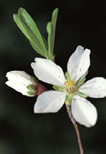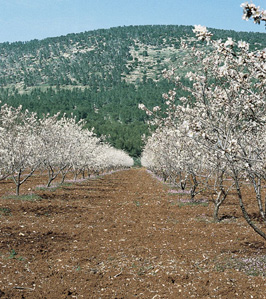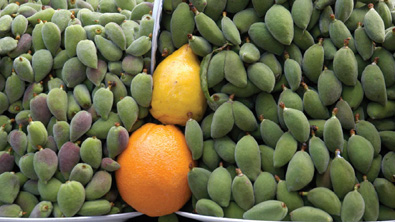

Flower, bud, and developing leaves of almond. Northern Israel.
BECAUSE ALMOND IS THE FIRST FRUIT tree to flower in the lands of the Bible and the Quran, it is a well-known symbol of resurrection. In fact, because it flowers as early as January, it is sometimes possible to see almond flowers on branches covered with snow. Almond, Prunus dulcis, is a medium-sized tree with narrow, light green leaves. Unlike the fig and olive, it does not live to a great age. The white or slightly pink, five-part flowers are up to 2 inches (5 centimeters) across and appear in the late winter before the leaves of the tree develop. They are bee pollinated even though the pollen contains bee toxins (Kevan and Ebert 2005). Because fruit production is dependent on bees, almond growers often keep beehives near their orchards to ensure that flowers are pollinated.
Within a month after flowering, the almond’s distinctive hairy, green fruits begin to develop. These immature fruits have a pleasantly sour taste and are sold by street vendors as a popular snack in the Middle East. My children enjoyed them when attending a Palestinian grade school. In the middle of August, the leaves begin to fall and the mature nuts are harvested.
Almond is related to stone fruit trees such as peach, apricot, and cherry: the seed is enclosed in a bony covering derived from the fruit wall. But unlike those relatives, the fruit of the almond is unusual: the leathery outer covering splits at maturity, releasing the stone.
Almonds are mentioned six times in the Bible, only in the Old Testament, and not in the Quran. The first Bible reference is in Genesis 43:11 (KJV), where Jacob orders his sons to take some of the “best products of the land” as a gift to Pharaoh when they travel to Egypt to request grain. The best-known reference is Aaron’s rod that budded: “Moses spoke to the Israelites, and all their leaders gave him one branch each, twelve branches in all for their families; Aaron’s branch was among them. Moses placed them before Yahweh in the Tent of the Testimony. On the following day Moses went to the Tent of the Testimony and there, already sprouting, was Aaron’s branch, representing the House of Levi; buds had formed, flowers had bloomed and almonds had already ripened” (Numbers 17:8, NJB).

Orchard of almonds in bloom in March, at the base of Mount Tabor, Israel.

Green almonds are a delicacy in the Middle East. Almonds of two different ages are visible on a Damascus vendor’s cart, in March. Those on the left are younger. They are sold with a packet of salt in which the sour, green fruit is dipped.
The most familiar component of the furniture of the biblical tabernacle is the lamp stand, or menorah. The almond motif was part of the divine design for the lamp stand in the tabernacle. Moses was instructed to make the bowls of the lamp stand in the shape of the almond flower. The exquisite symmetry of the flower may be why almond is the model for the menorah. Almond buds and fruits were also to be present: “The first branch must carry three cups shaped like almond blossoms, each with its calyx and petals; the second branch, too, must carry three cups shaped like almond blossoms, each with its calyx and bud, and similarly for all six branches springing from the lamp stand” (Exodus 25:33, NJB; 37:19–20, NJB).
The reference to almonds in Ecclesiastes 12:5 is difficult to interpret: “When going uphill is an ordeal and you are frightened at every step you take—yet the almond tree is in flower and the grasshopper is weighed down and the caper-bush loses its tang; while you are on the way to your everlasting home and the mourners are assembling in the street” (NJB). The word translated “in flower” can mean two apparently contradictory things (Seow 1999): the reference could be to masses of white flowers on the almond tree, which can be an allusion to the white hair of old age, or it could mean “to be despised.”
Almonds remain one of the most popular nuts. Although eating almonds is not mentioned in the Bible or the Quran, the ancients surely appreciated their culinary value and health benefits.